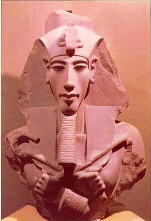During the 18th dynasty, suddenly came a religious revolt in ancient Egypt, led by Amenhotep IV. During his 5th regnal year, the king announced a new religion for the state, the “Atonism”. This involved worshipping only one god, Aton (the solar disc), and rejecting all other currently known gods. To this effect, the king changed his own name into “Akhen-Aton”(This pleases Aton), closed all other gods' temples and moved his capital north to Tel el-Amarna away from the influence of the priests of Amon. This religious revolt has been considered by all historians as the first significant step towards monotheism. Despite previous attempts by Menes (Narmer) in the 1st dynasty, and Khufu (Cheops) in the 4th, both conditions were more politically tinged than religious.
The new religion was totally rejected by all priests as well as the people themselves. With the disappearance of Akhen-Aton (killed or banished), the Amonism, the original official cult of the state was restored.
The period of his reign, as well as his immediate successors has tempted modern historians to study the personality of Akhen-Aton, whom later pharaohs have considered an atheist, schismatic and heretic.
Such study of his personality could never be fulfilled without noticing his characteristic physical features. His mummy, statues and reliefs were meticulously studied and assessed by physicians, particularly endocrinologists, since the start of the 20th century AD. His odd features could not be simply attributed to his foreign descent (Asian blood) from his maternal side. His undue tall stature and feminine-like appearance has raised suspicion that he was suffering from a certain medical syndrome.

Mariette, the famous French Egyptologist argued that Akhen-Aton was castrated, but such claim was rejected. He was known to have 6 daughters (and possibly at least one son, his successor, Smenkh-Ka-Ra, from a secondary wife Kiya).
The striking features found from the study of his statues, pictures as well as his mummy (if it were truly his) were those of tall stature, unduly long limbs, elongated skull, long slender neck and long face with a huge mandible (lower jaw).
In addition, his feminine features included gynaecomastia (female-like breasts) and a wide pelvis with fat hips (the breadth of the pelvis exceeds that of the shoulders – a characteristic feature of females). A nude statue during his early reign showed him without genitalia at all.
Moreover, he showed a redundant belly in all his pictures.
Studies of the assumed mummy and specifically the ossification of bony epiphyses (union between the bone shaft and its both ends) have concluded a “bony age” of 26 years (according to Prof. Eliot Smith) or 23 years (Prof. Derry). This age does not match his chronological age as estimated by Egyptologists and historians, which was 37 – 40 years at his death or disappearance.
Such discrepancy obviously is caused by delayed bony ossification, a condition known in medicine to be due to retarded sexual gland activity. However, no one can tell for sure that the mummy under such study was truly his.
In 1907, Prof. Eliot Smith has added to these findings a slight hydrocephalus (fluid accumulating inside the brain cavity) and epilepsy. Careful study of the skull has negated the presence of any hydrocephaly. In addition, epilepsy is known to leave no pathological marks on the skull. It is diagnosed in the living by measuring the electrical impulses from the brain. Such claims would certainly be untrue.
Review of his pictures throughout different stages of his life is also very helpful. His early reliefs do not show any deformity, while the later ones do. This denotes a disease presenting later in life, at least not during childhood or adolescence.
Several diagnoses were suggested. The earliest was Florisch's syndrome. Other suggestions included Marfan's and Kleinfilter's syndromes as well as pituitary gland dysfunction.
Florisch's syndrome
Florisch's syndrome, a disease caused by pre-pubertal pan-hypo-pituitrism (diminished secretion of the pituitary gland occurring before puberty) has been suggested.
If this occurs before puberty, it is usually due to a disturbance in the hypothalamus, and the endocrine hormone-secreting system.
If it occurs after puberty, it is usually a result of a tumor of the pituitary gland (chromophobe adenoma or craniopharyngioma).

The syndrome is characterized by retarded puberty, hypogonadism (diminished sexual activity) and feminine-like fat distribution (thighs, hips and breasts) that could be the case with Akhen-Aton.
However, it is essentially characterized by dwarfism (if occurs before puberty) and obesity, and normal stature (not increased) if it occurs after puberty.
Akhen-Aton's body built was characteristically tall, and not obese at all.
Kleinfilter's syndrome
This is a congenital chromosomal abnormality characterized by the presence of one or more extra X (female) chromosomes. Instead of the normal karyotype (XY in males or XX in females), the patient has a total number of chromosomes between 47 – 49 (1 – 3 extra X chromosomes), giving a karyotype of XXY, XXXY, or XXXXY.
This abnormality occurs as a result of non-dysjunction of the sex chromosome during gametogenesis in one of the parents (usually the mother). The extra X chromosome(s) is/are responsible for mal-development of the testes. Usually the disease does not become manifest before puberty.


Gynaecomastia (female-like breasts), small testes and later infertility are the main features. Secondary sexual characters (as voice changes, body hair distribution, etc) are often poorly developed. The patient is infertile but with normal libido (sexual drive).
Tall stature and elongated limbs occur in severe cases, with the span (length of extended upper limbs) exceeding the height. Mild obesity and under-developed musculature are also features of the disease.
Patients with 3 extra X chromosomes (XXXXY) are mentally retarded and have characteristic facial features (epicanthic fold, and slanting palpebral fissure), together with kyphoscoliosis (bending of the spine) with the little finger curving inwards.
Marfan's syndrome

Oil portrait of a Cardinal by EL-Greco
Metropolitan Museum of Art, New York
This is an inherited disorder of the elastic tissue, as well as the skeleton, cardiovascular system and the eye. The patient is usually tall, but the abnormality in bodily proportions is more significant than the tall stature (long limbs, particularly their end parts), resulting in elongation of the fingers or toes (arachnodactyly). Hyper-laxity of the joints (wide range of motion of the joint) is a very common feature.
Though these may be evident since birth, they become obvious after puberty. Longitudinal growth is everywhere resulting in dolicephaly, high-arched palate, long narrow face and prognathism. The patients are said to resemble portraits by El-Greco.
Despite these bony growth abnormalities, usually the bony age is normal and proportional to the chronological age.
Eye manifestations include ectopialentis in 50-70% of the cases, which is manifest as tremors of the iris (iridodonesis), cataract and severe myopia (short sight).
Cardiovascular manifestations include a dilated aorta, probably with dissecting aneurysms, and an incompetent aortic valve.
Hyper-pituitrism: Gigantism or Acromegaly
Both conditions occur as a result of excessive secretion of growth hormone by the pituitary gland.
If this occurs before fusion of the bony epiphyses (i.e. during childhood), gigantism becomes the case with excessive skeletal growth.
When this increased secretion occurs after epiphyseal fusion (i.e. during adulthood), acromegaly would be the case, resulting in tissue overgrowth, particularly the bones, which increase in thickness rather than length. This usually affects the hands, feet, and head and face bones.
Acromegaly is usually associated with pituitary adenoma (eosinophil, chromophobe or mixed-cell types), which grows slowly and does not metastasize.
If excessive secretion occurs before puberty, the patient shows an increased stature in comparison to his chronological age. The span (length of outstretched upper limbs) exceeds the height, and lower body measurement exceeds the upper one (distance between the symphysis pubis and soles exceeds that between the crown to symphysis pubis). Later in life, acromegalic features are added.

On the other hand, when the disease starts after puberty, acromegaly becomes manifest as a large long face with coarse features, prominent mandible (lower jaw), enlarged hands and feet, large thorax, kyphosis (bent spine) and enlarged inner abdominal organs.
Loss of libido (sexual drive) and potency may occur in male patients, together with gynaecomastia (female-like breasts) and maybe galactorrhoea (milk secretion from the male breasts) as well. The thyroid gland is often enlarged as well.
Excessive secretion of the growth hormone, maybe on the other hand a result of precocious puberty (onset of puberty before the age of 10 years). Hypogonadism (diminished sexual activity) occurring after puberty would secondarily lead to increased secretion of the pituitary gland as a compensatory mechanism. This results in failure (or delayed) epiphyseal fusion, and disproportionate growth of the limbs in comparison to the trunk.
Other suggestions
Other scholars (Prof. Paul Ghaliongi) have suggested a liver disease, namely tuberculosis of the liver or cirrhosis secondary to Bilharzial parasitic infestation (an endemic disease in Egypt).
Both conditions could contribute to the gynaecomastia and feminine features, particularly with late development. In addition, the redundant belly of Akhen-Aton could be a result of ascitis (fluid accumulation inside the abdominal cavity) secondary to liver dysfunction.
However, a liver disease fails completely to explain the bony abnormalities Akhen-Aton was suffering from.
What was Akhen-Aton suffering from?
It is obvious that Frolisch's syndrome or a liver disease could be easily ruled out.
Klienfilter's syndrome could be ruled out as well. Despite of the skeletal abnormal features of the disease that resemble Akhen-Aton's condition, as well as gynaecomastia and small testes, two characteristic features of the disease are inconsistent. Akhen-Aton was neither obese nor infertile. Egyptologists give hard evidence that he had had children.
Marfan's syndrome could not be ruled out. Though the skeletal anomalies are suggestive, there are no evidence of any cardiovascular or eye manifestations to support this likelihood, even if the mummy found was his. It was a tradition to remove the eye during the process of embalmment. Moreover, the feminine-like manifestation would still remain unexplained.
The most likely diagnosis of Akhen-Aton's disease is hyper-pituitarism. All bony abnormalities seem to favor such diagnosis, together with the sexual ones. A late onset of acromegaly or delayed hypo-gonadism sound to be most descriptive for his illness.
Further studies of the mummies and pictures of Akhen-Aton's family might be an additive. The mummy of his grandfather Yoya (maternal side) shows a tall man with thick lips and large nose.
The mummies of his two successors Smenkh-Ka-Ra and Tut-Ankh-Aton (Tut-Ankh-Amon) also show large skulls. Both are thought by some Egyptologists to be his sons from a secondary wife, Kiya.
The early death of a younger brother at young age should also be kept in consideration.
All reliefs of Akhen-Aton's family show that this large elongated skull was a common feature among his daughters, and his wife Nefertiti as well. This has led some scholars to believe that this skull feature has become a model of Egyptian art during this time. Nefertiti, the six princesses and all the court as well were so depicted as a compliment to Akhen-Aton.
If this suggestion is untrue, then the possibility of a hereditary disease - rather than an acquired one - is very likely.




